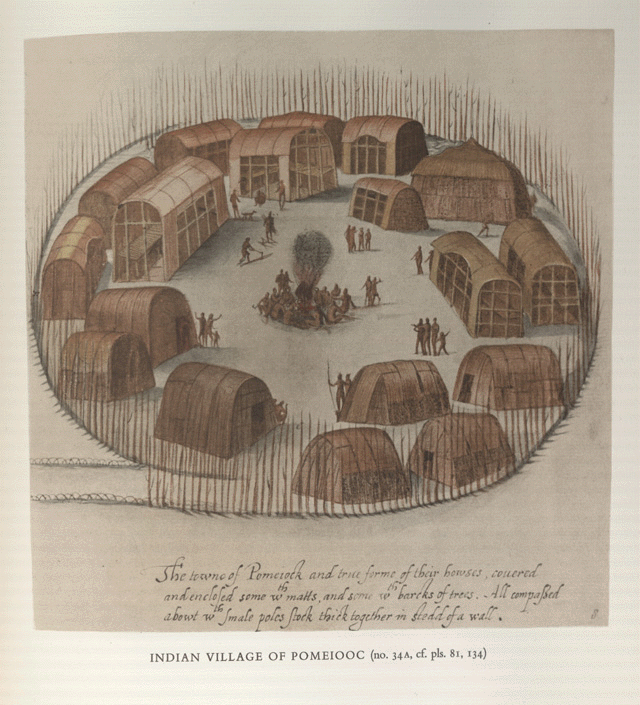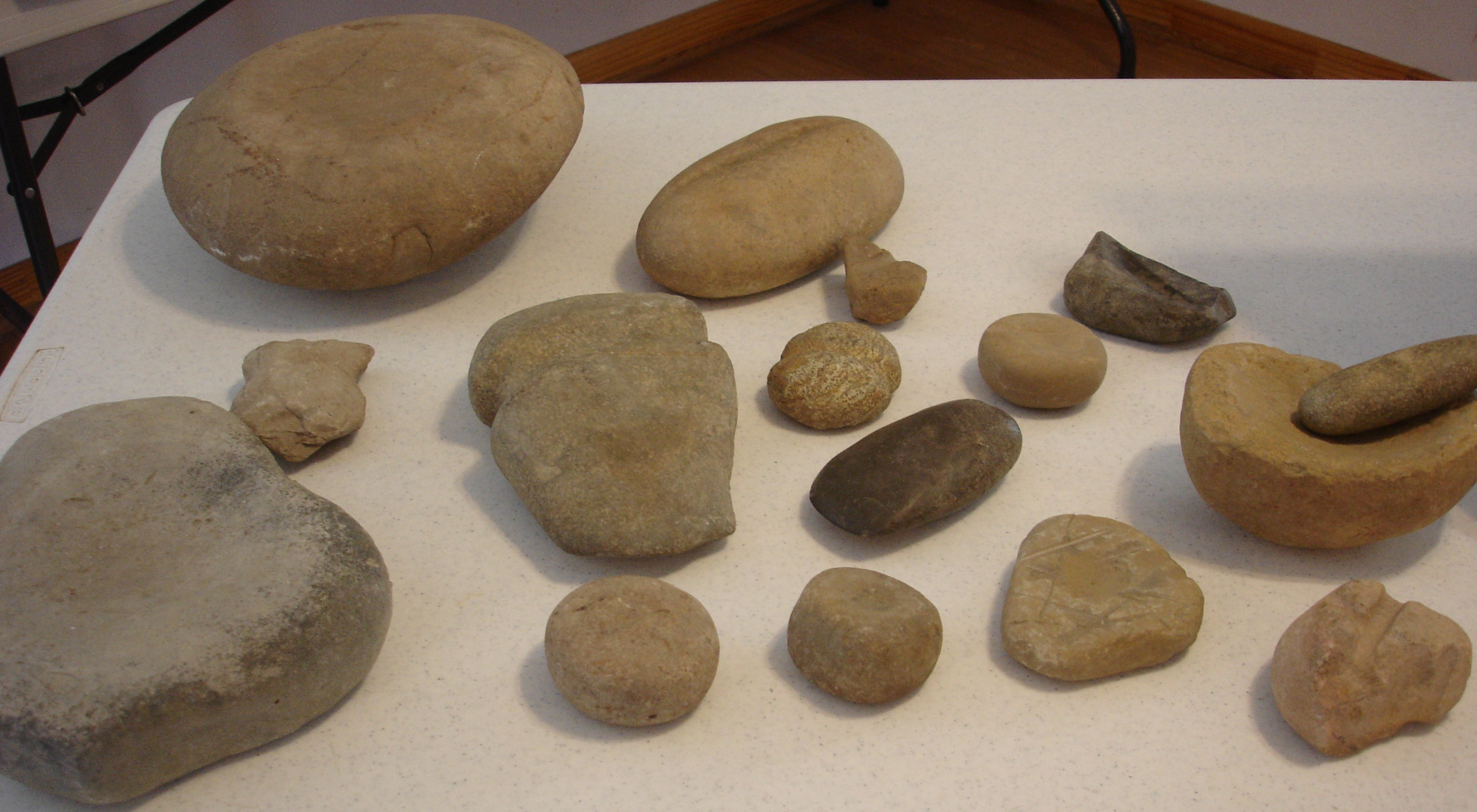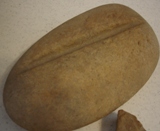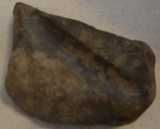
Updated March 18, 2012.
March 18, 2012. APPRAISAL OF ARTIFACTS
December 19, 2010. INDIAN BURIAL GROUND from the Jane Brumley Collection.
December 19, 2010. INDIAN'S ON SWAN ISLAND
July 18, 2010. Lecture by Larry Etheridge at the July 13, 2010 History of Knotts Island Meeting
Larry began by saying the Indians in this area were known as Algonquins (meaning they spoke the Algonquin language) He showed us pictures drawn by artist and adventure John White (of Roanoke Island.). John White and Ralph Lane had been to the area before as explorers and adventurers. John White was sent as an artist so he could paint the things he saw.
Larry thinks that the Indians on Knotts Island were from the Chesapeans Tribe. They were on Broad Bay, Pungo and down to Knotts Island along the ridge now route 615. The drawings by White showed villages with quasi-hut type houses made from young saplings bent over the top and tied with other branches intertwined and covered with mats.Men and women used hides from animals for clothing. They chewed the hides to make them soft. Bird feathers (mostly the bald eagle) were used for head dressings. Woven mats and sit upons were made from leaves, grasses and reeds. The mats were also used as the final cover for houses.
The Indians on Knotts Island were not wanderers. They had plenty to eat from the waters like oysters, clams, crabs and fish. They had ducks, swan, bears, deer, rabbits and other small game. They ate nuts including black walnuts, hickory nuts, hazelnuts, and chestnuts. They grew their own vegetables such as potatoes, sweet potatoes, corn, melons, squash and picked wild berries before the English got here. They knew how to store these vegetables thru the winter. Larry told of the Indians smashing the walnuts with large stones and putting them in boiling water. The water released the nut from the shell and the nuts floated on the surface so they could be scooped off the top of the water. The shells sank to the bottom of the pot. The meat and fish were smoked or dried for winter use and cooked on spits over an open fire. Dry corn was used to grind meal for flat cakes of bread. The Chespeans used wooden bowls shaped by charring out pieces of wood and removing the inside wood to form a bowl. Cups were from turtle, clam or conch shells. The Indians were also good at curing themselves of sickness with herbs. Willow bark was used for fevers, diarrhea, and as a poultice for sores. The bark was boiled into a tea ½ to one ounce were given to the patient every three or four hours.
There is a book on Indian medicine published in 1883 by J. I. Lighthall who was born in 1856. He went to Kansas and the Indian Territory to learn about the Indians medicines. Mr. Lighthall was part Indian. He was fascinated by the Indian doctors gathering roots, barks, leaves and flowers and assisted them in gathering nature’s remedies and manufacturing them into Indian remedies. He observed that the Indian doctors never injured their patients with their innocent remedies and soon the patients recovered. He became strongly impressed that what was good for an Indian certainly was good for a white man and he introduced Indian Herbal Theory. Mr. Lighthall was a botanist and understood the medical properties of herbs.
Larry said that scientists had discovered by examining Indian bones that they died mostly of gum disease and rotting teeth.
Larry said that the Chesapeake Bay was once called the Santa Maria. The Spanish came to this area before the English and had named the bay. In the early records you will see the name Santa Maria Bay.
The Indians here on Knotts Island did not use canoes. They used boats that were made from hollowed out logs. Fire was started in the middle of the log and stone chisels (different sizes) were used to hollow out the middle of the log to form the boat. Paddles were used to propel the boats.
The Indians had a religion. They believed in one supreme being with many small Gods. For example God of sun and moon and God of the animals were under the one supreme God. They believed in good and evil and that there was a life after death.
L arry
had many stone tools that he has found in Knotts Island over the
years.
Most were
found on his grandfather’s and father’s farm
after a hard rain, or when a large tree
fell over, or along the shores of the Island. Many of these stones
were
used
for different jobs. Holes were drilled
into some that were used as jewelry or for
a certain chore. The hole was made by using a bow with a string
made
of vine, it could be turned. Sand was used between the stone and
bow
to cause the friction to help make the hole.
arry
had many stone tools that he has found in Knotts Island over the
years.
Most were
found on his grandfather’s and father’s farm
after a hard rain, or when a large tree
fell over, or along the shores of the Island. Many of these stones
were
used
for different jobs. Holes were drilled
into some that were used as jewelry or for
a certain chore. The hole was made by using a bow with a string
made
of vine, it could be turned. Sand was used between the stone and
bow
to cause the friction to help make the hole.
 The
Indians here were perfectionists. The
quality of their stone work was exceptional compared
to most areas. There were small pestles
and small bowls for grinding herbs to large bowls and pestles for
grinding corn. Hammers and axes of
different sizes were used according to the job that needed to be
done. Larry showed us a big axe type
hammer with no blade used to help uproot tree roots. Most of the
work of dressing the skins for clothes, planting the gardens,
and grinding the corn was done by the women. The men did the
hunting, fishing and clearing the land
for the gardens.
The
Indians here were perfectionists. The
quality of their stone work was exceptional compared
to most areas. There were small pestles
and small bowls for grinding herbs to large bowls and pestles for
grinding corn. Hammers and axes of
different sizes were used according to the job that needed to be
done. Larry showed us a big axe type
hammer with no blade used to help uproot tree roots. Most of the
work of dressing the skins for clothes, planting the gardens,
and grinding the corn was done by the women. The men did the
hunting, fishing and clearing the land
for the gardens.
A
 shaft stone was used in shaping straight arrows. The stone was
heated and the arrow was pulled through the stone which
had a grove in it. Paint dishes were used to hold paint made
from berries, red clay, bear grease, etc. Paint
was used to adorn their bodies for war
and ceremonies. The Indians were able to keep records by putting
notches in stones. Larry showed us an
example of one of these stones. The Indians had their own
sandpaper,
made from rocks, and used to smooth their arrows shafts.
shaft stone was used in shaping straight arrows. The stone was
heated and the arrow was pulled through the stone which
had a grove in it. Paint dishes were used to hold paint made
from berries, red clay, bear grease, etc. Paint
was used to adorn their bodies for war
and ceremonies. The Indians were able to keep records by putting
notches in stones. Larry showed us an
example of one of these stones. The Indians had their own
sandpaper,
made from rocks, and used to smooth their arrows shafts.
Larry said he had not found a whole pottery pot, just fragmented pieces, probably because wooden bowls were used by the Chesapeans.
Larry’s collection showed many arrow heads, spear heads and tomahawks. One or two of them dating back to the clovis and paleo periods 6,000 to 8,000 years ago.
Larry left us with a message. It is very hard to find traces of the Indian culture here. Will the same be said of us four or five hundred years from now?